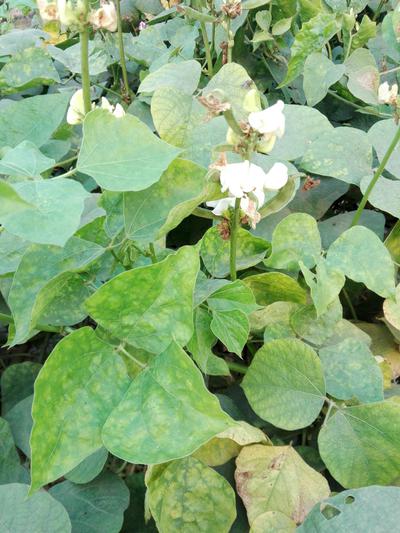Bean Common Mosaic Virus
BCMV
Virus
In a Nutshell
- Light and dark green mosaic pattern on leaves.
- Raised, puckered or distorted leaves.
- Downward leaf curling.
- Stunted growth.
Can also be found in
Symptoms
Initially, trifoliate leaves become slightly lighter in color. Gradually, a light and dark green mosaic pattern appears on the leaf blades (green-on-green mosaic). Some veins or parts of them show sign of chlorosis (yellowing). As the disease progresses, parts of the leaves might become puckered, blistered or distorted. Curled down or rolled leaves are other late symptoms. Plants which were infected during the early growth stages may be severely stunted and unproductive, with fewer pods and fewer seeds per pod. In some susceptible varieties, the virus can cause the blackening of roots, a symptom that is only observed at temperatures above 30°C.
Recommendations

Organic Control
Direct treatment of the virus is not possible. Diluted mineral oils can reduce the transmission of the virus by aphids, but in high concentrations these oils might be toxic to the plants.

Chemical Control
Always consider an integrated approach with preventive measures together with possible biological treatments. Chemical treatment of viral infections is not possible. Chemical control of the aphid vector is often ineffective.
What caused it?
The primary source of inoculum are infected seeds. The secondary transmission from plant to plant occurs via infected pollen, vectors pests (mostly aphids) or through mechanical injury to the plants during field work. Symptoms and effects on yield depend on plant variety, environmental conditions (temperature and humidity) and time of infection. Runner beans seem to be immune to the virus, while pole beans and bush beans are more vulnerable. Losses of up to 100% can be found in susceptible plants grown from seeds carrying the virus (seed-borne infection). Later infections by aphids are usually less severe. At temperatures above 30°C the symptoms worsen.
Preventive Measures
- Use healthy seeding material from certified sources.
- Plant resilient varieties whenever possible.
- Plant densely to prevent aphids from entering the canopy.
- Plant early to avoid aphid peak populations.
- Remove infected plants when first symptoms are observed.
- Cultivate beans far from other bean production sites.
- Rotate crops with non-host plants.
- Plant companion crops to block the aphids.



